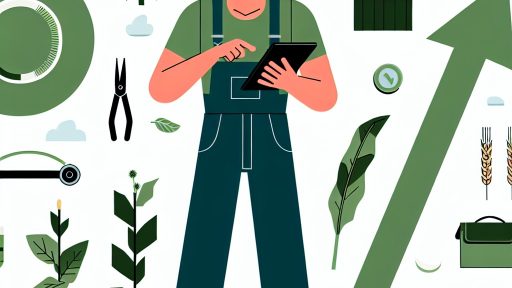Introduction to Biogas
Definition of Biogas
Biogas is a renewable energy source produced from organic materials.
This energy source primarily consists of methane and carbon dioxide.
Microorganisms break down organic matter through anaerobic digestion.
Farm waste, manure, and crop residues serve as common feedstocks.
Basics of Biogas Production
The biogas production process begins with collection of organic waste.
Next, operators load the organic materials into a digester.
Temperature control and anaerobic conditions are crucial for effective breakdown.
After digestion, biogas can be captured for energy use.
Additionally, digestate remains, which can be used as fertilizer.
Benefits of Biogas on Farms
Biogas production enhances farm sustainability by reducing waste.
Furthermore, it lowers greenhouse gas emissions from agricultural operations.
Farmers can generate their own energy, minimizing dependence on external sources.
This process also improves soil health through the application of digestate.
Biogas contributes to a circular economy in farming.
The Biogas Production Process
Anaerobic Digestion Explained
Biogas production primarily relies on anaerobic digestion.
Transform Your Agribusiness
Unlock your farm's potential with expert advice tailored to your needs. Get actionable steps that drive real results.
Get StartedThis process occurs in the absence of oxygen.
Microorganisms break down organic matter to produce biogas.
Feedstocks such as animal manure play a crucial role.
Other materials include crop residues and food waste.
The Stages of Anaerobic Digestion
Anaerobic digestion consists of four key stages.
The first stage is hydrolysis.
In hydrolysis, complex organic materials break down into simpler compounds.
Next is acidogenesis.
Diverse bacteria convert sugars and amino acids into volatile fatty acids.
Then comes acetogenesis.
This phase involves converting fatty acids into acetic acid, hydrogen, and carbon dioxide.
The final stage is methanogenesis.
Methanogenic bacteria produce methane from acetic acid and carbon dioxide.
Overall, these stages work together efficiently.
Biogas Components
Biogas primarily consists of methane and carbon dioxide.
Methane typically represents 50 to 70 percent of the gas.
Carbon dioxide usually accounts for around 30 to 50 percent.
Applications of Biogas
Farmers can utilize biogas in various beneficial ways.
It serves as a renewable energy source for heating and electricity.
Additionally, biogas can power vehicles.
Furthermore, the digestate left over can enrich soil.
This digestate acts as an organic fertilizer for crops.
Environmental and Economic Benefits of Anaerobic Digestion
Anaerobic digestion provides numerous environmental and economic benefits.
It reduces greenhouse gas emissions from waste management.
Showcase Your Farming Business
Publish your professional farming services profile on our blog for a one-time fee of $200 and reach a dedicated audience of farmers and agribusiness owners.
Publish Your ProfileThis process also minimizes odors and pathogens in waste products.
Moreover, it allows farmers to generate their energy, reducing costs.
Types of Feedstocks for Biogas Production
Agricultural Residues
Agricultural residues are by-products from farming operations.
These residues include crop leftovers like straw, husks, and leaves.
They are abundant and often underutilized, making them ideal for biogas production.
Farmers can efficiently collect and process these materials.
This process not only reduces waste but also generates renewable energy.
Moreover, using residues for biogas can improve soil health.
When returned to the land, they enhance nutrient cycling and organic matter.
Livestock Manures
Manure from livestock provides another valuable feedstock.
It contains high amounts of organic matter that can be converted into biogas.
Dairy farms and pig farms often produce significant quantities of manure.
Utilizing manure reduces odors and mitigates water pollution risks.
Furthermore, it provides farmers with an additional income stream.
Farmers can sell excess energy produced from manure digestion.
In addition, using manure for biogas contributes to carbon footprint reduction.
Compost and Organic Waste
Compost and other organic waste are also excellent feedstocks.
These materials include food waste and garden refuse.
They complement agricultural residues and manure effectively.
Composting these materials before digestion enhances biogas yield.
Moreover, it helps in managing waste efficiently.
Utilizing organic waste aids in closing the nutrient loop on farms.
This practice supports sustainability and resource conservation.
Benefits for Sustainable Farm Management
Using diverse feedstocks promotes sustainable farming practices.
Biogas production reduces reliance on fossil fuels.
It encourages synergies between crop and livestock operations.
This dual approach maximizes resource use on the farm.
Moreover, it offers a holistic solution for nutrient management.
Farmers investing in biogas technology often see increased resilience.
They can adapt to market changes more effectively.
Learn More: Growing Medicinal Plants in Agroforestry Systems Across the USA
The Role of Biogas in Farm Sustainability
Environmental Benefits
Biogas production significantly reduces greenhouse gas emissions.
It captures methane, a potent greenhouse gas, from organic waste.
This process helps mitigate climate change effects considerably.
Additionally, biogas production promotes waste management practices.
Farmers can repurpose manure and food waste effectively.
This reduces the need for chemical fertilizers, enhancing soil health.
Furthermore, it decreases reliance on fossil fuels for energy.
Biogas serves as renewable energy, powering farm operations sustainably.
Moreover, it provides a resource for heating and electricity generation.
Showcase Your Farming Business
Publish your professional farming services profile on our blog for a one-time fee of $200 and reach a dedicated audience of farmers and agribusiness owners.
Publish Your ProfileUsing biogas can lower energy costs for farmers.
It creates a closed-loop system, benefiting both the environment and economy.
Implementing biogas technology fosters community engagement and collaboration.
Farmers can share resources and knowledge, enhancing overall sustainability.
Improved Soil Health
The use of digestate, the byproduct of biogas production, enriches the soil.
This organic material enhances nutrient content in the soil.
Consequently, it improves soil structure and moisture retention.
Farmers observe better crop yields through sustainable practices.
Healthy soils also support increased biodiversity on farms.
These practices promote the establishment of beneficial microorganisms.
Resource Efficiency
Utilizing biogas technologies promotes resource efficiency on farms.
It allows farmers to maximize the potential of their organic waste.
This innovation minimizes waste disposal issues commonly faced.
Efficient waste conversion reduces environmental pollution risks.
Farmers can implement biogas systems with varying scales and budgets.
This adaptability facilitates widespread adoption among diverse agricultural operations.
Learn More: Sustainable Irrigation Practices for Organic Farming Operations
Economic Benefits of Biogas for Farmers
Cost Savings on Energy
Farmers can significantly reduce their energy costs by utilizing biogas systems.
These systems convert organic waste into renewable energy.
This energy can power farm operations, which lowers electricity bills.
Farmers gain independence from fluctuating fossil fuel prices.
Waste Management Savings
Biogas systems help reduce the costs associated with waste disposal.
Farmers can convert manure and crop residues into valuable biogas.
This process lessens the burden of waste treatment procedures.
It also minimizes the need for chemical fertilizers.
New Revenue Streams
Implementing biogas technology creates new revenue opportunities.
Farmers can sell excess energy back to the grid.
They can market bio-fertilizers produced from the digestate.
These products appeal to environmentally conscious consumers seeking sustainable options.
Access to Grants and Incentives
Many government and non-profit programs support biogas initiatives.
Farmers can access financial incentives for installing biogas systems.
Grants can offset initial investment costs, boosting profitability.
These resources encourage farmers to adopt renewable energy practices.
Improved Farm Resilience
Biogas production contributes to overall farm resilience.
By harnessing renewable energy, farmers protect themselves from price volatility.
They diversify income sources, which enhances economic stability.
These practices prepare farms for future agricultural challenges.
You Might Also Like: Sustainable Goat Farming Methods for Milk and Meat Production
Technological Innovations in Biogas Systems
Emerging Technologies in Biogas Production
Biogas production has seen significant advancements in recent years.
New technologies improve efficiency and yield in production systems.
Showcase Your Farming Business
Publish your professional farming services profile on our blog for a one-time fee of $200 and reach a dedicated audience of farmers and agribusiness owners.
Publish Your ProfileFor instance, anaerobic digestion methods have evolved dramatically.
Recent innovations allow for more effective breakdown of organic matter.
This enhances gas production from a variety of feedstocks.
Integration with Smart Farming
Integrating biogas systems with smart farming technology is a growing trend.
Farmers can monitor production in real-time using sensors.
This data helps optimize feedstock input and energy output.
Additionally, smart grids enable better energy management.
As a result, farmers can maximize efficiency and reduce waste.
Biogas Upgrading Technologies
Upgrading technologies convert raw biogas into higher-quality biomethane.
Membrane separation and pressure swing adsorption are key methods.
These technologies remove impurities, enhancing biomethane purity.
Consequently, farmers can use this high-quality gas more effectively.
This also allows for easier integration into natural gas networks.
Challenges and Future Directions
Despite these advancements, challenges still exist in biogas production.
Issues such as feedstock availability and economic viability remain critical.
For example, reliable sourcing of organic material is essential.
Moreover, regulatory frameworks often hinder the expansion of biogas systems.
Looking ahead, increased research and collaboration are vital for sustainability.
Recent Trends in Biogas Sector
Policy Support and Market Growth
Government policies increasingly support renewable energy solutions.
This support is vital for the growth of the biogas market.
Effective policy frameworks encourage investment in technology.
Farmers benefit from incentives that promote biogas production.
Community-Driven Projects
Community-based biogas projects demonstrate local sustainability.
These initiatives encourage collaboration and resource sharing.
Moreover, they educate farmers about renewable energy options.
Such projects often lead to successful local economies.
Research and Development Initiatives
Research institutions are actively pursuing biogas innovations.
Collaborative efforts focus on improving digestion processes.
Additionally, they aim to enhance the overall sustainability of operations.
This ongoing research is crucial for the evolution of the sector.
Uncover the Details: How Agroforestry Supports Pollinators and Biodiversity in the USA

Case Studies: Successful Biogas Projects in Agriculture
Introduction to Biogas Projects
Biogas projects have become essential for sustainable agriculture.
They convert organic waste into renewable energy.
This process reduces the carbon footprint of farming practices.
Moreover, it enhances soil health through nutrient recycling.
Farmers’ Experience: Green Acres Farm
Green Acres Farm successfully implemented a biogas system in 2020.
Located in Iowa, they utilize livestock waste for energy production.
As a result, they significantly lower their energy costs.
This farm produces biogas that powers operations and heats buildings.
The surplus energy is sold back to the grid.
Showcase Your Farming Business
Publish your professional farming services profile on our blog for a one-time fee of $200 and reach a dedicated audience of farmers and agribusiness owners.
Publish Your ProfileBenefits Observed at Green Acres Farm
The farm has reported increased profitability since adopting biogas technology.
They improved waste management practices and decreased landfill reliance.
Additionally, the farm attracts eco-conscious consumers.
Collaboration: Green Energy Cooperative
This cooperative promotes biogas projects among local farmers.
Multiple farms joined forces to establish a shared biogas facility.
The facility processes manure and crop residues efficiently.
Farmers benefit from reduced waste and shared operational costs.
Innovation and Community Impact
The cooperative introduces innovative fermentation technology.
They conduct educational workshops for farmers on biogas advantages.
As a result, there is a growing community interest in renewable energy.
Case Study: Smith Family Dairy
Smith Family Dairy implemented biogas production in 2018.
They focused on using cow manure to generate energy.
This project has decreased their reliance on fossil fuels.
Furthermore, it provides a stable energy source for daily operations.
Environmental and Economic Advantages
The dairy has observed notable reductions in methane emissions.
Consequently, their environmental footprint has decreased significantly.
The savings from energy costs have contributed to farm expansion.
Implications and Future Directions in Biogas Adoption
These case studies illustrate the benefits of biogas production.
Farmers gain financially and contribute to environmental sustainability.
As technology advances, more farms may adopt these systems.
The agricultural sector stands ready to embrace renewable energy solutions.
Challenges and Barriers to Biogas Adoption in Farming
Economic Factors
The initial investment for biogas systems can be substantial.
Farmers often face budget constraints that limit their choices.
Additionally, the return on investment may take several years.
This financial uncertainty discourages many potential adopters.
Technical Challenges
Biogas technology requires specialized knowledge and skills.
Farmers may struggle with the maintenance of biogas systems.
Inadequate technical support can exacerbate these issues.
Moreover, varying feedstock availability complicates operation.
Regulatory and Policy Issues
Regulatory frameworks can hinder biogas project development.
Many regulations lack clarity regarding biogas production.
Additionally, obtaining necessary permits can be time-consuming.
Farmers often find navigating environmental compliance challenging.
Social Perception and Awareness
There is a general lack of awareness about biogas benefits.
Many farmers remain unconvinced about its profitability.
Social stigma surrounding waste treatment can also hinder adoption.
Furthermore, limited networking opportunities restrict knowledge sharing.
Infrastructure Limitations
Access to reliable infrastructure is crucial for biogas systems.
In rural areas, this infrastructure may be underdeveloped.
Transporting feedstock and produced biogas can be problematic.
Showcase Your Farming Business
Publish your professional farming services profile on our blog for a one-time fee of $200 and reach a dedicated audience of farmers and agribusiness owners.
Publish Your ProfileInadequate storage facilities can also limit operational efficiency.
Future Potential of Biogas in the Context of Renewable Energy Policies
Expanding Biogas Production
Biogas production is gaining traction globally.
Many countries aim to increase renewable energy shares.
Farmers can harness waste to produce biogas efficiently.
This process reduces greenhouse gas emissions significantly.
Moreover, biogas serves as a sustainable energy source.
Government Incentives and Policies
Governments are introducing frameworks to support biogas projects.
Incentives include grants and tax breaks for farmers.
Moreover, policy adjustments are encouraging renewable energy adoption.
For instance, Europe has set ambitious renewable energy targets.
These initiatives help foster a favorable market environment.
Decentralized Energy Solutions
Biogas offers decentralized energy generation options.
Farmers can produce energy close to where it is used.
This reduces transportation costs and losses.
Consequently, local communities benefit through energy access.
Additionally, it supports energy independence for rural areas.
Challenges and Innovations
Despite its potential, biogas production faces challenges.
Initial investments for biogas systems can be high.
Moreover, technical expertise is often required.
However, innovative technologies are emerging to overcome these issues.
For example, advancements in digesters are enhancing efficiency.
Prospects for Sustainable Energy Growth
The biogas sector is set for significant growth.
As technology improves, production costs are likely to decrease.
Furthermore, increasing awareness of climate change boosts demand.
Collaboration across sectors can streamline biogas project implementation.
Ultimately, biogas has a pivotal role in sustainable energy futures.
Additional Resources
Climate Change Impacts on Agriculture and Food Supply | US EPA
American Farmers’ Next Hot Commodity Is Canola for Biofuels | Luis …




